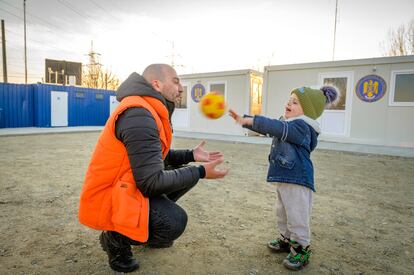As the armed conflict continues in Ukraine, more than half of the country's children, and almost 12 million people in total, have been forced to flee their homes and seek safety at home and abroad.
At the beginning of this conflict, in early March, I visited the Ukrainian city of Lviv as part of my work with the World Vision response team.
I went to assess the ongoing displacement situation and meet potential partners with whom we could work in response to this huge humanitarian crisis.
Although no shelling had yet taken place in Lviv, the sense of fear was widespread, with local citizens prepared to flee in the event of an attack.
When we finished our assessments and headed to Poland, suddenly and abruptly, we became part of a flow of about 200 Ukrainian refugees.
They were desperately trying to get to this country after leaving their homes, businesses, family and belongings behind to escape the war.
I had seen many times on television and in the newspapers images of long lines of refugees crossing borders to flee the turmoil in Iraq or Syria, but being stuck in one of them was absolutely surreal.
He was crossing with the refugees, step by step, breath by breath, as the line approached the Polish border.
Alyona and her three-year-old daughter Bella play in the Romexpo shelter in Bucharest, the capital of Romania.Brianna Piazza
It was an extremely emotional and painful experience.
She could feel the agony, the anguish, the fears and also a kind of hope along the 300 meters that separate the borders.
Almost all of the refugees who crossed with us were women, children and the elderly;
With few exceptions, men are prohibited from leaving Ukraine.
It broke my heart to see so many boys and girls with disoriented eyes, not fully understanding how their lives had changed so drastically in just a few days.
The mothers tried to pull themselves together as they comforted their children, burying their tears and despair deep inside, saying goodbye to their roots and walking towards an uncertain future.
The pain and mourning that each and every one of them carried on their shoulders was visible.
As I woke up next to them, I felt how completely unfair life was: we were crossing the same border, but my situation was very different.
I had a passport that allowed me to travel almost everywhere, I had a hotel reservation waiting for me in Poland, and once my deployment was over I would fly safely back home.
They marched into the unknown and faced having to process deep feelings of loss, be it of a loved one, of a homeland, of social status, of well-being, of a future.
It broke my heart to see so many boys and girls with disoriented eyes, not understanding how their lives had changed so drastically in just a few days.
These refugees are on a journey that they have not chosen, most of them do not have sufficient economic resources to pay for a place to stay or eat.
Above all, they have lost almost everything in their country of origin.
Most of them wonder: where to go? Where to start a life? When will we be able to return to our village? How many of our relatives who stayed behind will survive?
We have all experienced pain in our lives and, most likely, have gradually overcome it.
However, when the situation that caused us the pain is not resolved or prolonged, such as a war, it is a challenge to reach the last stage of grief, when we can move on and build a new life without the deep sense of loss.
When humanitarian organizations respond to refugee crises, we do not limit ourselves to meeting their basic needs.
It is essential to examine the intersection between the psychosocial damage produced by the war, the throbbing wound of the migration or evacuation process, and their struggles to adjust to a new life in the host community.
Many displaced people will have directly experienced persecution, hunger and poverty;
they will have been witnesses to violence or direct victims of it, as well as abuses.
Many of the children I saw were traveling without relatives who could protect them or, in some cases, had adult caregivers with them, but they were so traumatized that they were unable to care for themselves.
A World Vision aid worker, Catalin Romanescu, plays with two-year-old Dima at a refugee reception center at the border. Laura Reinhardt
Mental health and psychosocial support should be considered a core component of all humanitarian interventions, especially at border posts, IDP shelters and reception centres.
Although most refugees are able to reach safety in arrival communities, the psychological impact of war, violence and separation from loved ones can continue for a long time.
Children and youth must be supported with the necessary tools to understand and deal with these painful experiences.
This is accompanied by education, livelihood, protection and health strategies.
As a professional and as a person, I am still processing this excruciating journey that I shared with those people.
I am now back at home and at my office, but I cannot forget every face and feeling I experienced that day.
Now that the number of refugees reaches almost seven million, we must never forget the human dimension of this humanitarian catastrophe, especially that of the most vulnerable.
Patricio Cuevas-Parra
is the director of Children's Rights and Participation at World Vision International.
Recently, he has spent several weeks in the region making assessments of the situation.

